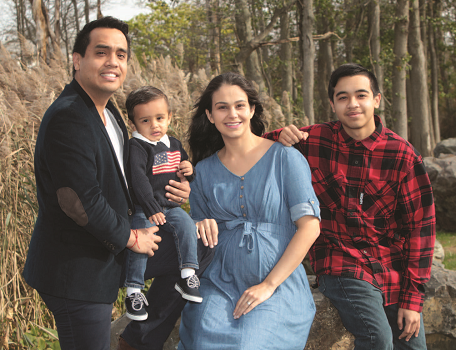“I would snore loudly, and during the day I’d be so tired I would fall asleep while standing or having a conversation.”

Orlando Reyes, 34, a supervisor of patient access management at Monmouth Medical Center (MMC), has had trouble sleeping ever since he was a child. “I would snore loudly, and during the day I’d be so tired I would fall asleep while standing or having a conversation,” he says.
In 2005, he was diagnosed with sleep apnea, a disorder that occurs when a person’s airway becomes blocked and he or she stops breathing briefly while sleeping.
Orlando had surgery to remove his tonsils, adenoids, and part of his tongue. Unfortunately, the procedure brought only temporary relief. Over the next 15 years, he continued to suffer and had occasional tests and treatments with no lasting results.
Last August, he saw Philip Passalaqua, MD, an ear, nose, and throat physician affiliated with MMC, who recommended that Orlando have a sleep test at MMC’s Comprehensive Sleep Disorders Center.

Traditionally, sleep testing has required an overnight stay in the hospital so patients can be monitored by technicians. Orlando discovered he could have the test in the comfort of his home.
“Home sleep tests have several advantages,” says Douglas Livornese, MD, Medical Director of the Center. “They’re much less invasive, and you can potentially get a better night’s sleep. They’re becoming more accurate, too.”
A Simple Setup
On the day of the test, Orlando picked up the equipment from the Center. At bedtime, he secured a small pack to his chest with an elastic band. Next, he placed a sensor beneath his nose and attached another sensor to one of his fingers, which would measure his oxygen and heart rate.
“The equipment was ready after these easy steps,” he says. “I was able to switch sleeping positions, and it was quiet.”
As Orlando slept, the test measured his breathing, heart rate, and oxygen level. The next day, he returned the equipment to the sleep center, where physicians analyzed the data recorded in the chest pack.
Dr. Passalaqua asked Orlando to spend a night in the hospital to determine whether a machine designed to treat sleep apnea would help him.
Orlando tried a continuous positive airway pressure (CPAP) machine, which delivers pressurized air to the back of the airway through a tube connected to a mask worn while the patient sleeps.
The CPAP treatment disturbed Orlando’s sleep, so the overnight technician swapped it for a Bilevel Positive Airway Pressure, or BiPAP, machine, which delivers different amounts of air pressure based on whether the patient inhales or exhales.
After some adjustments to the settings, Orlando slept peacefully.
The BiPAP machine has been life-changing.
“I don’t wake up feeling like a truck hit me,” says Orlando. “And I’m not pressing ‘snooze’ on my alarm clock as much.”
For more information, visit the Comprehensive Sleep Disorders Center at Monmouth Medical Center. To make an appointment, call (732) 923-7660.